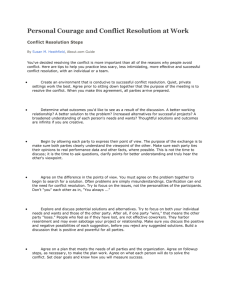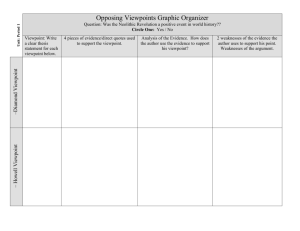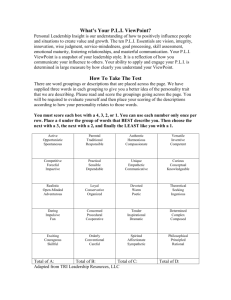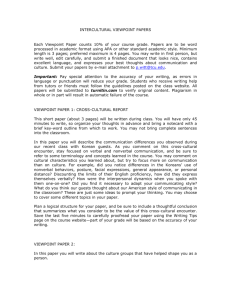dealing with children and families
advertisement
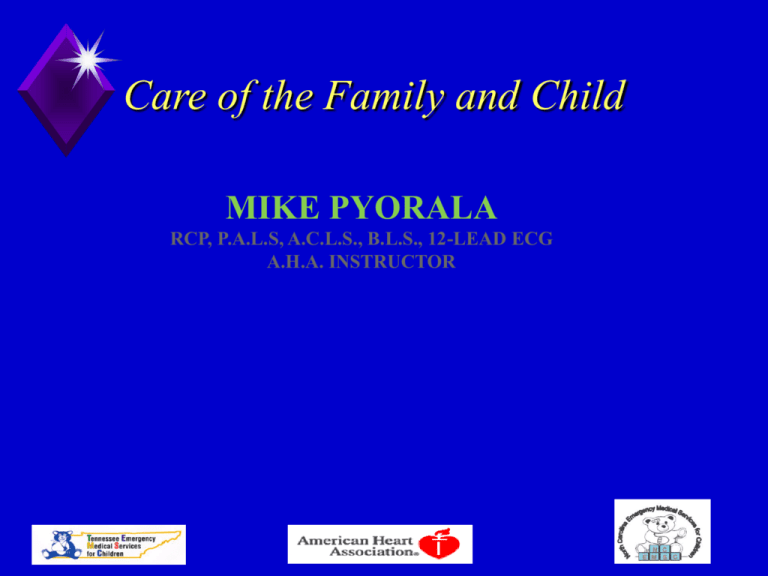
Care of the Family and Child MIKE PYORALA RCP, P.A.L.S, A.C.L.S., B.L.S., 12-LEAD ECG A.H.A. INSTRUCTOR Care of the Family and Child Objectives Psychological aspects Developmental issues Approach Assessment Care of the Family and Child Why are psychological and emotional needs difficult to manage? Care of the Family and Child Psychological Aspects Child’s viewpoint Parent’s viewpoint Health Care Provider’s viewpoint Care of the Family and Child Crisis CHALLENGES Individual Unit Care of the Family and Child Child’s Viewpoint Pain Fear Guilt Care of the Family and Child Parent’s Viewpoint Frightened Guilty Exhausted Care of the Family and Child Health Care Provider’s Viewpoint Scared Inexperienced Empathetic Care of the Family and Child Child’s Responses Care of the Family and Child Care of the Family and Child Care of the Family and Child Care of the Family and Child Key Points Be honest Give real choices Support family relationship Maintain self-control Respect right to privacy Care of the Family and Child Key Points Assume the child can hear you. Do not introduce fear/anxiety. Praise children. Care of the Family and Child Parental Responses Decreased ability to: accept and understand incoming information think clearly and to solve problems Helplessness Anxiety Hysteria Anger Guilt Care of the Family and Child Assessment Perception of the event Previous experience Family relationships Culture/religion Support systems Care of the Family and Child Strategies Include the parents and child Ask for the parent’s assistance Acknowledge feelings Be honest Stay calm Familiarize family with the environment Give control Prepare the family Care of the Family and Child Developmental Issues The child’s chronological age may not always match the developmental age. Care of the Family and Child Care of the Family and Child Care of the Family and Child Care of the Family and Child Care of the Family and Child Care of the Family and Child Care of the Family and Child Care of the Family and Child Physical Examination Does the child look sick? Does the child sound sick? Care of the Family and Child Primary Survey Appearance Airway and C-spine Breathing Care of the Family and Child Remember: Many problems, especially respiratory distress, are made worse by agitation. Care of the Family and Child Approach Varies with age Care of the Family and Child Less than 1 month of age Respond to Soothing voice Gentle hands Pacifier Keep warm Exam chest and abdomen first Care of the Family and Child Infant (1-6 Months) Unafraid of strangers Responds to cooing and tickling Keep warm Exam chest and abdomen first Care of the Family and Child Infant (6-12 Months) Afraid of strangers Separation anxiety Examine in parent’s lap Examine trunk then proceed to head Care of the Family and Child Toddler (1-3 Years) Independent Strong distrust of strangers Patient but firm approach Keep parents nearby Limit exam to bare essentials Care of the Family and Child Preschooler (3-5 Years) Frightened of bodily injury Need explanations and reassurance May be more cooperative Modest Examine in presence of parents Examine chest and abdomen first Care of the Family and Child School-Age Child (6-12 Years) Cooperative More aware of death Need reassurance Modest Examine with parents present Examine in an adult fashion Care of the Family and Child Adolescent (12-18 Years) Expect to be treated as an adult Many of the same fears as younger children Body image Excessively modest Examine as an adult Care of the Family and Child The approach to the unconscious child of any age is the same as for the unconscious adult, with rapid performance of the primary survey and institution of priority treatments. Care of the Family and Child Tips on Treatment Talk to all patients of all ages Give explanations in simple language Be honest Be sympathetic Offer reassurance Carefully document Care of the Family and Child Vital Signs Vary with age Care of the Family and Child Broselow® Resuscitation Tape Care of the Family and Child Weight Critical measurement (Age in years x 2) + 8 = weight in kilograms Care of the Family and Child Respirations Count respirations before touching the child. Count for 1 full minute to assess: quantity quality effort Care of the Family and Child Heart Rate Newborn Infant/young child Older child Umbilical Cord Brachial artery Carotid artery Care of the Family and Child Remember : In Shock, Heart rate rises long before blood pressure falls!!!!!! Care of the Family and Child Remember: Bradycardia in an ill child indicates extreme distress, requiring URGENT intervention. Care of the Family and Child Blood Pressure Wide range of normals May see up to 25% decrease in blood volume before BP decreases. Over one year may estimate minimum systolic: (Age in years x 2 ) + 70 = minimum systolic blood pressure Care of the Family and Child Remember: Never wait until the child is hypotensive to initiate volume resuscitation!!!!!! Care of the Family and Child Temperature Children cool quickly Exposure and low cardiac output lower core temperature Care of the Family and Child Neurological Anterior Fontanel Bulging or tense Sunken Care of the Family and Child LOC Alertness Eye contact Recognition of parents Playing Withdrawal to pain Care of the Family and Child Talk Reassure Be Honest Carefully document Care of the Family and Child Care for Yourself Discuss and review difficult pediatric cases Critical Stress Debriefings


